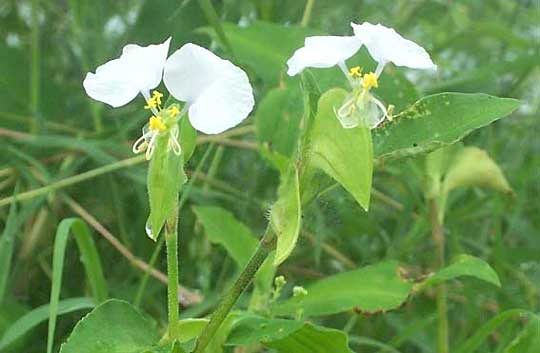Excerpts from Jim Conrad's
Naturalist Newsletter
from the July 27, 2007 Newsletter issued from Sierra Gorda Biosphere Reserve, QUERÉTARO, MÉXICO
DAYFLOWERS
I want to be sure you know what dayflowers are, for they're elegant little beings with unusual floral anatomy, and in much of North America, as well as here along weedy roads, they're blossoming now. Four dayflower species are listed for the Reserve; six are described in the Flora of the Carolinas.
Dayflowers are species of the genus Commelina. The one flowering along our weedy roadsides now is COMMELINA ERECTA, sometimes called the Whitemouth Dayflower. See it below:

The blossoms in the above picture hold two large petals above their sexual parts, like white fans. A handlens reveals a third tiny, white petal just below the ovary, and that petal is what gives the plant its Whitemouth name. The top two petals of most members of this species are blue, but around here ours are white, which sometimes happens.
Dayflower blossoms have 3 sepals, 3 petals, 6 stamens of which only 3 are fertile, and the fruits usually are 3-celled capsules. The flower parts being in threes and multiples of three makes sense since dayflowers are monocots, thus closer to lilies and grasses than to dicot daisies and oaks. Dicot flower parts usually appear in fours, fives, or multiples thereof.
One unusual feature of dayflower blossoms is that the three infertile stamens, called staminodes, are yellow, as well as the middle one of the three fertile stamens. In the picture the yellow items are the staminodes and the middle fertile stamen, all held a bit above the ovary. Also you can see the pale two fertile stamens held below the ovary. Surely the splotch of yellow attracts pollinators and the position of the two fertile stamens assures that pollinators get dusted with pollen.
Another unusual feature of dayflower blossoms is that they arise from flower-size, green, leaflike bracts folded down the middle to form something like barely open, flattish clamshells. You can see the bract very clearly beneath the flower on the right in the picture. These bracts protect the delicate blossoms in the bud stage. And, delicate the blossoms are, as the name "dayflower" suggests -- the flowers supposedly lasting only a day before vanishing.
The plants themselves, however, are tougher. Our Whitemouth species is robust enough to inhabit a large distribution area, occurring across much of the US, and south through Mexico into Central America.
Dayflowers belong to the Spiderwort Family, the Commelinaceae.